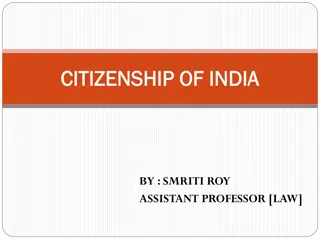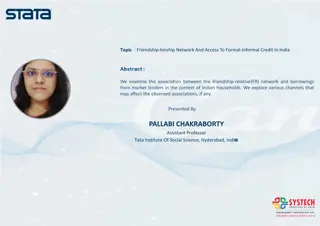Transformation of Indian Two-Wheeler Market: Factors and Impacts
The Indian two-wheeler market has undergone significant transformation driven by factors like demographic changes, regulatory policies, technological advancements, and socio-cultural shifts. These changes have impacted the industry by influencing consumer demand, market segmentation, and competitive dynamics. Firms that strategically analyze and adapt to these environmental changes are more effective in staying competitive. Case in point, Bajaj's strategic moves in introducing new models, discontinuing old ones, rebranding, and investing in R&D to attract the youth segment.
Download Presentation

Please find below an Image/Link to download the presentation.
The content on the website is provided AS IS for your information and personal use only. It may not be sold, licensed, or shared on other websites without obtaining consent from the author. Download presentation by click this link. If you encounter any issues during the download, it is possible that the publisher has removed the file from their server.
E N D
Presentation Transcript
TRANSFORMATION OF INDIAN TWO WHEELER MARKET
Business Environment Demographic Internal Environment (Control) Economic Suppliers Cultural Values Mission Objectives Co. Image Human Resource Inter- mediaries Customers Macro Environment (Respond) Legal Political Competitors Micro Environment (Influence) Technological
Factor Changes Impact on Industry Demographic Urbanization Growing youth population Increased Demand Increased demand for stylish bikes Development of new market segment Regulatory or Policy Broad banding of license New Models leading to Market development Joint Ventures between Indian and foreign co.s Break-up of JVs Foreign co.s set up wholly owned subsidiaries Indian co.s had to go alone Liberalized FDI regulations 100% FDI Technological Fuel-efficient Bikes Fall in demand for Scooters and old- tech bikes (Chetak, Rajdhoot, Yezdi, Yamaha, Kinetic Honda etc.) New demand from women and old age people Scooters and Scooterettes for dual / family use Switch-start Auto Gear Scooters Socio-Cultural Acceptance of employment / education for women New demand for sleek, stylish, lower CC scooterettes from women
Factor Changes Impact on Industry Socio-Cultural Changes in dressing Increased demand for all categories of two-wheelers Pent-up rural demand Increased travel needs among rural India Economic Increasing disposable incomes Reduced interest rates Easy availability of credit for purchase of automobiles Increased demand for two / four wheelers Shift from two-wheeler to four- wheeler Second hand two-wheeler market Auto co.s started NBFCs to provide easy-financing options New Work Inadequate public transport facilities Competition Intensified with entry of MNCs Improved market due to availability of variety of scooters and bikes After-sales Service network had to be created with trained technicians Create world-class R&D facilities to face foreign competition
Factor Changes Impact on Industry Political Economic Reforms Liberalization Privatization Globalization Reduced breakdowns due to Improved road conditions Increased demand for all categories of two-wheelers as buying capacity of all segments of people improved tremendously Internal Environment Investment on R&D facilities Changing / re-crafting strategies to compete with MNCs Changing Brand / Co. Image
Question: Firms which systematically analyze and diagnose the environment are more effective than those which don t . Comment in the light of the above case. Answer Bajaj Introduced bikes and discontinued Chetak. Changed its Brand Image to attract youth. Invested on R&D, Distribution, After-sales Service and Marketing to withstand the competition from MNCs Hero, TVS Developed R&D to stay in the competition after breaking-up of JVs with foreign partners Kinetic Disappeared from market after breaking-up of JV with Honda. Rajdhooth, Yezdi, Road King Could not survive in the new competition from Japanese automakers

















































